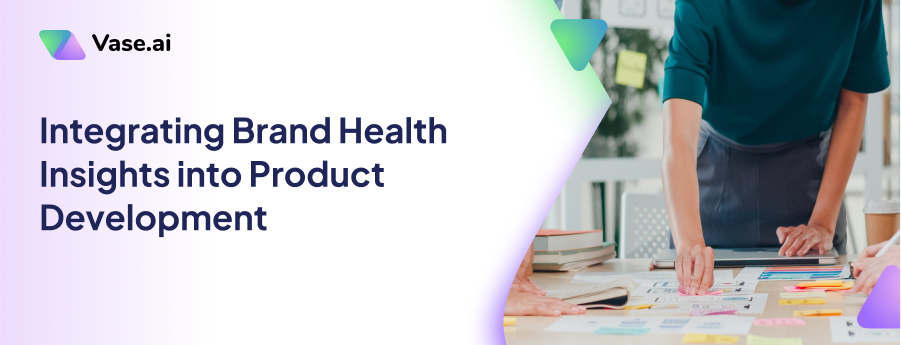Imagine walking into your favorite café and finding that your cherished dish has changed. It tastes different, and suddenly it feels like a piece of your everyday comfort is missing.
This isn’t just a matter of taste. It’s a connection between you and the brand that’s been disrupted.
Integrating customer feedback isn’t about ticking boxes on a survey. It’s about understanding these deep feelings and using them to create products that truly resonate.
But how do you do that? Let’s dive in and find out.
Here's What We'll Cover:
- Incorporating Insights into Product Design and Development
- Measuring Impact: Feedback Loops and Continuous Improvement
- Win By Turning Raw Data Into Actionable Insights
Incorporating Insights into Product Design and Development
Customers trust a brand more and stick around longer when they witness their ideas shaping product development.
Emotional Impact of Product Changes
Do you know that a slight shift in your brand's approach, if not done correctly, can trigger consumer resistance?
Innovation is good, but it carries risks.
See how Burger King’s revamped version of its iconic Whopper burger has stirred up debate among loyal fans in the UK. Customers are arguing that the new recipe strays too far from the classic Whopper flavor they’ve adored for decades.
To remedy the situation, the brand needs to gather more real-time consumer feedback. Therefore, Burger King is now celebrating Whopper Day with free giveaways before deciding on a nationwide rollout.
This isn’t just a story about burgers—it’s a lesson for all businesses. Understanding what customers feel and need is essential to creating products that truly resonate. When brands ignore the authentic voice of their consumers, even iconic names can suffer costly missteps.
At its core, every product change creates an emotional response. When customers form a bond with a product, even a small tweak can feel like a major betrayal.
Many brands face the same challenges: lost opportunities, wasted budgets, and frustrated teams that keep hitting a wall when it comes to product innovation.
If you can relate to this, it’s time to rethink your approach. You need to start confronting the real pain points—those gaps between your brand’s promise and your customers’ expectations.
This is the power of incorporating brand health insights in product development. It’s the art of listening to those whispers in the market and then creating products that resonate deeply with customers.
Customer-Centric Design
Customer-centric design means building your product around what real people say they need. If you want to make good sales, you need to put your customer at the heart of every decision.
Take the example of Amazon, which famously “works backwards” from the customer.
Amazon continuously derives feedback from product reviews, browsing history, and support interactions. Based on this data, its recommendation engine employs techniques like collaborative filtering and content-based filtering to generate personalized product suggestions.
For instance, if a customer buys a camera, the system immediately suggests lenses, memory cards, and related accessories that previous buyers often purchased together. This not only increases the likelihood of additional purchases but also boosts the average order value.
According to a McKinsey report, Amazon’s recommendation algorithm drives roughly 35% of its sales. And the algorithm is not static. It’s continuously refined based on real-time feedback from millions of interactions.
Netflix does the same. A standout example is the success of “House of Cards,” which helped Netflix attract 3 million new subscribers within three months.
Successful brands know that product development isn’t just about launching new features. It’s about understanding and responding to customer needs. When companies integrate brand health insights into every stage of product development, they turn raw feedback into meaningful experiences that build trust, drive loyalty, and fuel growth.
Iterative Testing
No product is perfect from day one. Iterative testing is the process of refining a product in stages. Instead of launching a final version right away, you create a prototype or beta version, and then refine it over and over until it really works.
Look at how Proton rolled out its Proton e.MAS 7. They released beta versions and monitored social media and direct feedback to fix issues before the full launch. This process helped them catch problems early, so when e.MAS 7 was finally launched, it received an overwhelming response.
Customers were drawn to its advanced safety features and semi-autonomous driving capabilities. Why? Because the car truly aligned with their desire for safety. In other words, Proton didn’t just launch a car. They crafted a wholesome experience for customers.
Using a structured approach for product concept testing ensures your new ideas hit the mark.
If you need a roadmap that guides you from the very first idea to a fully refined product, we have one for you here.

Cross-Functional Collaboration
Great products rarely come from a single department. Instead, they are the result of cross-departmental collaboration. Why? Because successful innovation requires a team effort.
Cross-functional collaboration means marketing, R&D, and product teams work together, sharing insights and aligning their goals. This joint effort ensures that every aspect of the product is consistent with the brand’s identity.
Take AirAsia as an example. Their team members share insights and feedback to update their services in real time.
A few years back, customers complained about the long, frustrating process of rebooking during flight delays. AirAsia’s team took notice. They enhanced AirAsia’s mobile app with new and innovative features. The updated app now automatically detects flight delays. It promptly presents customers with tailored alternative flight options. This ensures a smoother rebooking process.
This upgrade reflects AirAsia’s commitment to addressing customer pain points.
Measuring Impact: Feedback Loops and Continuous Improvement
Once you’ve integrated customer insights into your product, the next vital step is to continuously monitor how these changes are resonating with your audience.
Think of launching a product like planting a seed. Right after launch, you need to check if it’s growing strong.
Feedback loops are essential. They let you know if your improvements are truly making a difference and provide guidance for further refinements.
But how do you know if your campaign efforts or product updates are delivering a solid return on investment?
Start tracking your sales. Also, continue tracking social media sentiment and customer surveys to see if your product truly resonates.
When Proton released its e.MAS 7, they didn’t stop at the launch event. They set up dashboards to monitor customer satisfaction and net promoter scores, ensuring every piece of feedback was captured and understood.
Ongoing monitoring is your daily watering routine. You need to keep checking what people are saying about your product online. This continuous check-up lets you fine-tune features. It allows you to swiftly correct any issues before they become problems.
Did you know that in 2019, Grab’s drivers started noticing that the app’s route suggestions during rush hour often led them into gridlocked areas? This was wasting their time and money.
Listening closely, Grab’s product team updated the route optimization algorithm using AI. It incorporated real-time traffic data. This helped drivers find faster, less congested routes during peak times. This change wasn’t planned months ahead. It was a rapid response to daily insights from the people on the road.
Making this update helped Grab:
- Improve drivers’ earnings.
- Save fuel costs.
- Boost rider satisfaction by ensuring more punctual pickups and smoother trips.
Use Our Post-Campaign Effectiveness Study
If you’re not sure where to begin, check out our post-campaign effectiveness study to truly quantify the impact of your advertising and branding efforts.

It is a fast-track guide to reveal which ad elements spark massive engagement and skyrocket your ROI. It lets you quickly measure brand and ad recall, and pinpoint exactly what consumers love (or hate) about your ads.
Our clients use it so they only invest in what really works for their brand.
Leverage Advanced Technology for Personalization
Today’s technology offers powerful tools to convert customer feedback into actionable insights. Artificial intelligence, for example, can help you analyze vast amounts of data to identify trends and personalize customer experiences.
Daily Harvest, a meal delivery service, uses AI to sift through order histories. This makes each order feel uniquely personal to the customer? How? When AI digs into order histories, it learns what customers love to eat.
For example, if a customer frequently orders green smoothies, the system might suggest a new recipe featuring kale or spinach. Then, by adjusting packaging based on real-time weather, it even ensures that the food arrives fresh and at its best quality.
This personalization creates a stronger bond with customers. They see that Daily Harvest truly understands their tastes and needs. This makes them want to order again and even try new offerings.
Similarly, Colgate-Palmolive is experimenting with “digital twins,” which are computerized simulations of consumers, to test new toothpaste ideas before launching them.
By leveraging these technologies, brands can quickly predict how changes will be received and make necessary tweaks before going to market.
Win By Turning Raw Data Into Actionable Insights
Integrating brand health insights into product development isn’t just about launching a product. It’s about creating a living, evolving offering that truly connects with your customers.
Start small, think big, and watch your brand transform with every iteration. If your every update and new feature reflects real insights, your product will build lasting brand loyalty.
However, managing these constant feedback loops can feel overwhelming.
If you’re struggling to turn raw data into clear, actionable insights, book a demo with us to learn how we can simplify the process for you.











![How to Conduct Competitive Analysis [With Templates]](https://www.vase.ai/hubfs/How%20to%20Conduct%20Competitive%20Analysis/CompetitiveAnalysis_HeroBanner.png)